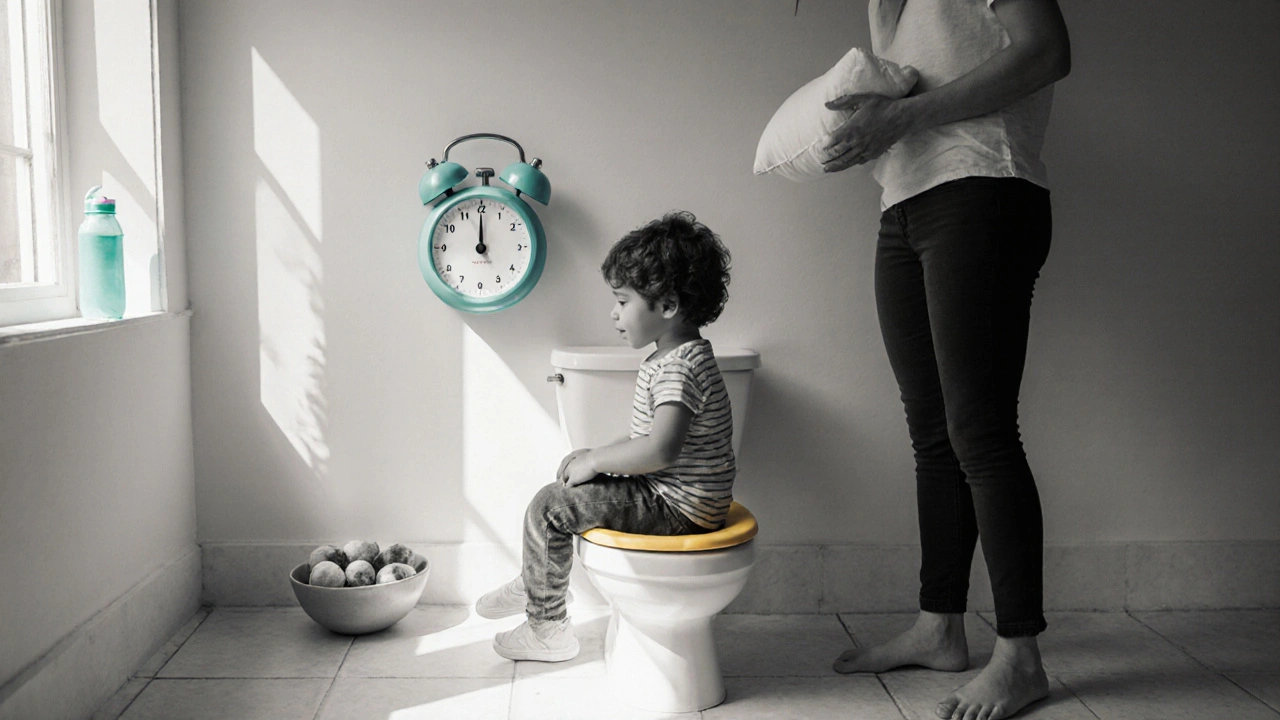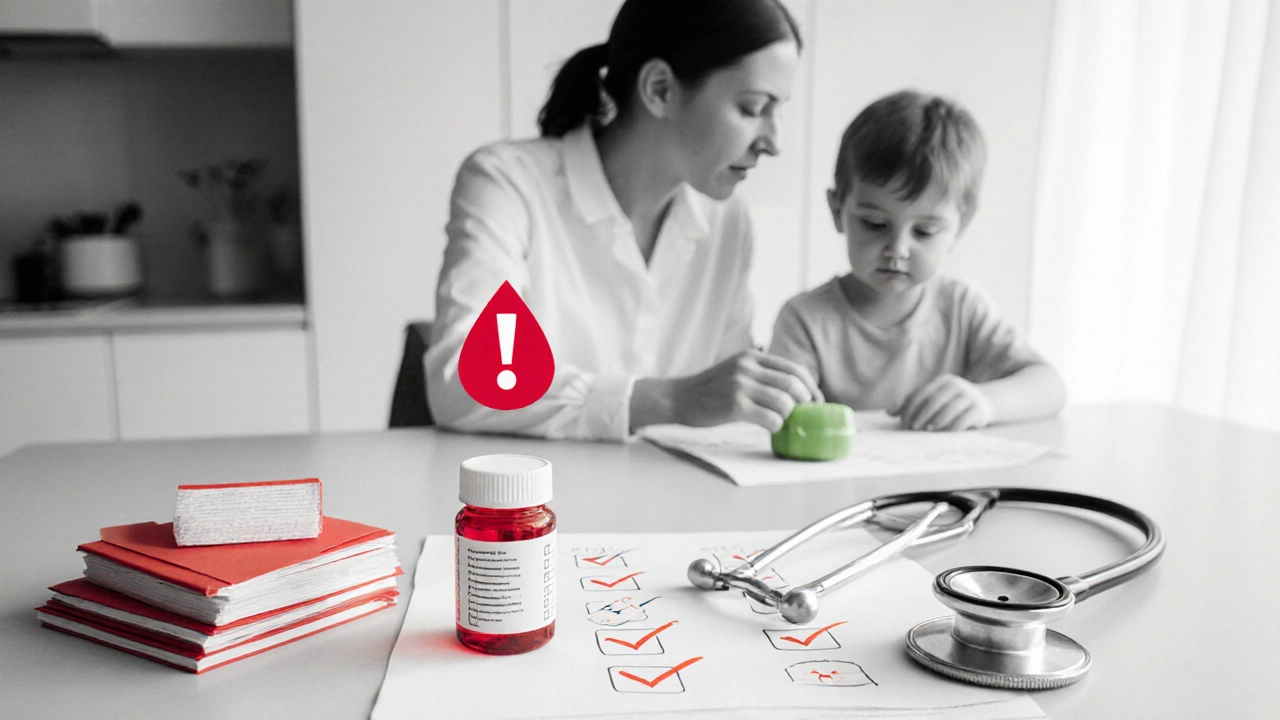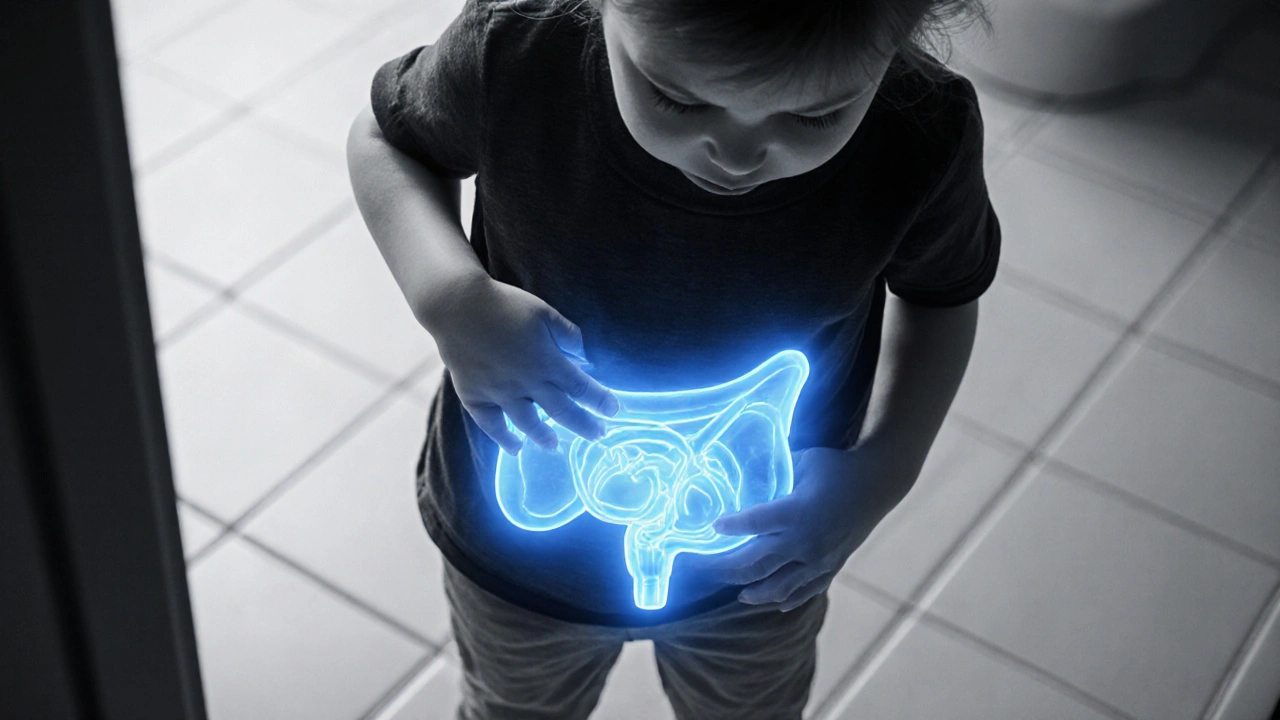Bladder Spasm Tracker
Daily Log
Track your child's bladder health and identify patterns
Today's Summary
No data entered yet. Enter information above to see your child's progress.
Red Flag Alert
No red flag symptoms reported today.
Key Takeaways
- Bladder and urinary‑tract muscle spasms in kids often stem from overactive detrusor muscles, constipation, or infections.
- First‑line care focuses on fluid‑timing, pelvic‑floor exercises, and behavioral bladder training.
- When non‑pharmacological steps fail, medicines such as anticholinergics or beta‑3 agonists can be added under pediatric supervision.
- Persistent pain, daytime wetting, or blood in urine signals a need for prompt medical review.
- A daily checklist helps parents track triggers, progress, and when to call the doctor.
Bladder muscle spasms are involuntary contractions of the detrusor muscle that line the bladder wall. These spasms cause a sudden, urgent need to pee and may lead to leakage, especially in children whose bladder control is still maturing. The condition is sometimes labeled overactive bladder (OAB) or detrusor overactivity.
Understanding why these spasms happen is the cornerstone of any management plan. Children are not just small adults; their nervous system, bowel habits, and emotional state all interact with bladder function.
What Triggers Muscle Spasms in Kids?
- Urinary‑tract infections (UTIs) irritate the bladder lining, making the detrusor muscle hyper‑responsive.
- Chronic constipation creates pressure on the bladder, reducing its capacity and prompting spasms.
- High‑caffeine or sugary drinks act as bladder irritants and increase urine production.
- Stress, anxiety, or attention‑deficit disorders can heighten nervous‑system signals to the bladder.
- Neurological conditions such as spina bifida or cerebral palsy directly affect muscle control.
Identifying the dominant trigger guides the choice of treatment. For most children, a combination of lifestyle tweaks and targeted exercises yields noticeable improvement within weeks.
Non‑Pharmacological Strategies (First‑Line)
These approaches require no prescription and are safe for most ages.
1. Fluid Management
- Offer water consistently throughout the day-aim for 1ml per kilogram of body weight per hour.
- Avoid carbonated drinks, tea, and coffee after 2p.m.; they contain caffeine that can trigger spasms.
- Limit juice to one small glass (≈120ml) a day; excess fructose can act as a bladder irritant.
2. Timed Voiding & Bladder Training
Teach the child to use the bathroom on a set schedule, gradually lengthening intervals.
- Start with 30‑minute intervals during school hours.
- Increase to 45‑minute intervals after two weeks if no leakage occurs.
- Reward successful dry periods with stickers or extra playtime.
3. Pelvic‑Floor Muscle Exercises
Strengthening the muscles that support the bladder can reduce involuntary contractions.
- Show the child how to stop the flow of urine mid‑stream (like pausing a water tap).
- Ask them to hold the contraction for 5seconds, then relax for 5seconds. Repeat 10 times, twice a day.
- For younger children, turn the exercise into a “squeeze‑the‑balloon” game using a small pillow.
4. Constipation Management
Regular bowel movements relieve pressure on the bladder.
- Increase dietary fiber to 14g per 1,000kcal (roughly 25g for a 6‑year‑old).
- Encourage a high‑water intake and daily physical activity.
- If needed, a pediatrician‑approved osmotic laxative (e.g., polyethylene glycol) can be used short‑term.
5. Behavioral & Stress‑Reduction Techniques
Calm‑down routines before bedtime, mindfulness breathing, and a predictable bathroom schedule can lower anxiety‑driven spasms.

When Medication Becomes Necessary
If spasms persist after 6-8weeks of disciplined non‑drug measures, a pediatric urologist may consider medication.
Common drug classes include:
- Anticholinergics (e.g., oxybutynin, tolterodine) - relax detrusor muscle contractions.
- β3‑adrenergic agonists (e.g., mirabegron) - increase bladder capacity.
- Topical estrogen - rarely used, mainly for post‑pubertal girls with atrophic changes.
Medication should start at the lowest pediatric dose and be titrated under close monitoring for side effects such as dry mouth, constipation, or blurred vision.
Comparison of Management Approaches
| Aspect | Non‑Pharmacological | Pharmacological |
|---|---|---|
| Primary Goal | Improve bladder capacity and control through lifestyle. | Directly relax detrusor muscle to stop spasms. |
| Typical Onset of Benefit | 2-4weeks with consistent practice. | 1-2weeks after dose adjustment. |
| Side‑Effect Profile | Minimal; occasional GI upset from increased fiber. | Dry mouth, constipation, possible blurry vision. |
| Ideal Candidates | All children, especially those with mild symptoms. | Persistent symptoms after 6weeks of first‑line care. |
| Cost Consideration | Low - mostly water, food, and time. | Moderate to high - prescription fees and follow‑up visits. |

Red Flags: When to Call a Healthcare Professional
Any of the following warrants immediate medical attention:
- Blood in urine or strong foul odor.
- Fever above 38°C (100.4°F) with urinary symptoms.
- Sudden increase in daytime wetting after a period of dryness.
- Severe pain during urination or a constant urge that disrupts sleep.
- Failure to respond to 8weeks of structured non‑drug management.
Daily Care Checklist for Parents
- Record fluid intake (type and amount) each day.
- Track bathroom visits - time, success, any leakage.
- Note bowel movements - consistency, frequency.
- Monitor for constipation signs: hard stools, abdominal discomfort.
- Review any medication doses and side‑effects.
- Schedule a weekly review with the child - praise successes, adjust goals.
Consistency is key. Even on “good days,” keep the routine; over time the bladder learns new patterns.
Frequently Asked Questions
What age can children start bladder training?
Most kids can begin simple timed voiding around 4‑5years old, once they can recognize the urge to go and can sit on the toilet unaided.
Is it safe to give my child over‑the‑counter laxatives for constipation?
Mild osmotic laxatives like polyethylene glycol are commonly prescribed for children, but you should always get a pediatrician’s dose recommendation first.
Can caffeine really affect a child’s bladder?
Yes. Even small amounts of caffeine can increase urine production and irritate the bladder lining, making spasms more likely.
How long does it usually take to see improvement with pelvic‑floor exercises?
With twice‑daily practice, most children notice fewer urgent urges within 2-4weeks, though full mastery can take 2-3months.
When is mirabegron considered for a child?
Mirabegron is typically reserved for children over 12years who have not responded to anticholinergics and have normal heart rhythm, as it can affect blood pressure.
Managing bladder muscle spasms children requires patience, consistency, and a willingness to adjust strategies as the child grows. With the right mix of lifestyle changes, targeted exercises, and, if needed, medication, most kids regain comfortable bladder control and can focus on school, play, and sleep without constant worry.


Ryan Wilson
October 15, 2025 AT 15:53Your "coach" tone feels like a lecture to parents who are already doing their best.
EDDY RODRIGUEZ
October 19, 2025 AT 18:53First off, kudos to any parent who dives into the nitty‑gritty of bladder training – it’s no joke. The key is to keep the momentum going, even on days when the kiddo seems resistant. Start with the fluid schedule: a steady sip of water throughout the day, aiming for roughly one milliliter per kilogram per hour, and ditch the soda after lunch. Then, set a timer for timed voiding; 30‑minute intervals at school work wonders for most four‑to‑six‑year‑olds. Celebrate every dry stretch with a sticker chart or a fun activity – positive reinforcement fuels consistency. Remember the pelvic‑floor game: have them practice “stop the flow” like a faucet, holding for five seconds, then relaxing. Pair that with a simple “balloon squeeze” for the younger ones, turning the exercise into play. Don’t overlook constipation; fiber and hydration are the unsung heroes that free up bladder space. If you notice persistent urgency after a week, revisit the caffeine intake – even mild coffee or tea can be a hidden trigger. Keep a daily log of fluids, bathroom trips, and bowel movements; patterns emerge that guide tweaks. When you’ve stuck to the plan for six weeks and still see frequent leaks, bring the pediatric urologist into the conversation for a medication review. Anticholinergics and β3‑agonists are options, but they come with side‑effects, so start low and monitor closely. Above all, stay patient and keep communication open with your child – they’ll feel more in control when they understand the why behind each step.
Emily Collier
October 23, 2025 AT 21:53The physiology behind detrusor overactivity is best addressed by first eliminating any external irritants, such as caffeine‑laden beverages and excessive fruit juice. Coupling that with a structured bowel regimen can dramatically reduce intra‑abdominal pressure, which often exacerbates spasms. Consistent timed voiding reinforces neural pathways that signal bladder fullness at appropriate intervals. Pelvic‑floor strengthening, when performed twice daily, typically yields measurable reductions in urgency within three to four weeks. Monitoring with a simple checklist empowers parents to identify patterns and adjust interventions promptly.
Catherine Zeigler
October 28, 2025 AT 00:53I love how the earlier comment highlighted the importance of routine; building on that, consider integrating a bedtime wind‑down ritual that includes deep‑breathing exercises. This can mitigate the stress‑induced component of overactive bladder, especially in children with ADHD. Adding a visual cue, like a chart on the bathroom door, reminds the child of the next scheduled void. Over time, these layered strategies compound, making the bladder’s response more predictable. Consistency truly is the cornerstone of success, and parents should celebrate incremental wins.
henry leathem
November 1, 2025 AT 03:53From a neuro‑urological standpoint, the interplay between somatic afferents and detrusor excitability necessitates a multimodal approach; reliance on monotherapy is suboptimal. Incorporating behavioral modulation alongside pharmacodynamics yields a synergistic effect that attenuates hyperreflexia.
jeff lamore
November 5, 2025 AT 06:53These recommendations align well with standard pediatric urology guidelines. Parents should consult their healthcare provider before initiating any medication.
Kris cree9
November 9, 2025 AT 09:53yeah but u cant just tell moms 2 drink water all day like its a miracle cure lol.
Paula Hines
November 13, 2025 AT 12:53One might argue that the cultural narrative surrounding pediatric bladder health is overly sanitized, ignoring the sociopolitical dimensions of dietary commodification; the ubiquitous presence of sugary beverages in schools, for instance, reflects a systemic failure that transcends individual parental agency, thereby necessitating a collective advocacy approach that confronts corporate interests and promotes legislated dietary reforms, ultimately fostering an environment where preventive strategies are not merely optional but enshrined within public health policy.
John Babko
November 17, 2025 AT 15:53Excellent summary! Let’s remember to keep the conversation inclusive and evidence‑based.